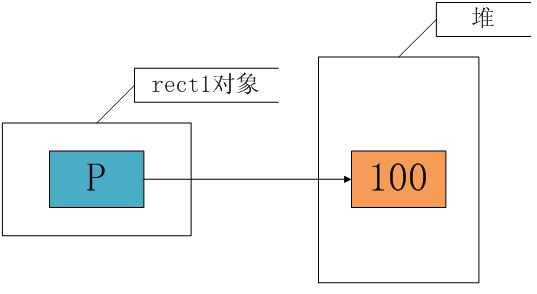1.C++构造函数和析构函数
构造函数:
构造函数在创建类对象时自动执行,通常用于一些数据的初始化工作,构造函数可以重载,有一个默认构造函数。
析构函数:
在释放对象所占内存时自动执行,不能重载,一个类只能有一个析构函数
构造函数和析构函数的执行顺序是,先构造后析构,后构造先析构,类似于栈,先进后出
#include <iostream>
#include <string>
using namespace std;
class CExample
{
public:
CExample(string);
~CExample();
private:
string m_name;
};
CExample::CExample(string name)
{
m_name=name;
cout<<m_name<<" object constructor Run."<<endl;
}
CExample::~CExample()
{
cout<<m_name<<" object destructor Run."<<endl;
}
void main()
{
CExample a("a");
CExample b("b");
}
a object consreuctor Run.
b object consreuctor Run.
b object desreuctor Run.
a object desreuctor Run.
这里,我们不比其他语言,需要new 。 不使用new的对象都存放在栈中。所以为什么b会先析构,a后析构
当然,我们把上面的代码改成如下:
#include <iostream>
#include <string>
#define SAFE_DELETE(p) if(p){delete(p);p=0;}
using namespace std;
class CExample
{
public:
CExample(string);
~CExample();
private:
string m_name;
};
CExample::CExample(string name)
{
m_name=name;
cout<<m_name<<" object constructor Run."<<endl;
}
CExample::~CExample()
{
cout<<m_name<<" object destructor Run."<<endl;
}
void main()
{
CExample *a=new CExample("a");
CExample *b=new CExample("b");
SAFE_DELETE(a);
SAFE_DELETE(b);
}
但是我们在学习C#的时候,好像是局部变量在方法结束后会自动释放,按理说main方法结束后 a和b应该会自动释放内存的啊 ,我们在改改代码,来验证下C++中是不是也一样
#include <iostream>
#include <string>
#define SAFE_DELETE(p) if(p){delete(p);p=0;}
using namespace std;
class CExample
{
public:
CExample(string);
~CExample();
private:
string m_name;
};
CExample::CExample(string name)
{
m_name=name;
cout<<m_name<<" object constructor Run."<<endl;
}
CExample::~CExample()
{
cout<<m_name<<" object destructor Run."<<endl;
}
void func()
{
CExample *a=new CExample("a");
CExample *b=new CExample("b");
}
void main()
{
func();
cout<<"main function run end"<<endl;
}2.拷贝构造函数
拷贝构造函数:
拷贝构造函数和对基本类型的变量赋值一样,但是拷贝的是类,类里面的结构是很复杂的,所以这里的深究一样。
using namespace std;
class CExample
{
public:
CExample(string);
//CExample(const CExample& c);
~CExample();
private:
string m_name;
};
CExample::CExample(string name)
{
m_name=name;
cout<<m_name<<" object constructor Run."<<endl;
}
CExample::~CExample()
{
cout<<m_name<<" object destructor Run."<<endl;
}
void main()
{
CExample a("a");
CExample b=a;
}
当执行CEXample b=a的时候,其实就调用了拷贝构造函数,如果没有显示指定一个拷贝构造函数,系统会有一个默认的,这个和构造函数一样。
我们看下面一段代码,显示指定一个拷贝构造函数
using namespace std;
class CExample
{
public:
CExample(string);
CExample(const CExample& c);
~CExample();
public:
string m_name;
};
CExample::CExample(string name)
{
m_name=name;
cout<<m_name<<" object constructor Run."<<endl;
}
CExample::~CExample()
{
cout<<m_name<<" object destructor Run."<<endl;
}
CExample::CExample(const CExample& c)
{
m_name=c.m_name;
cout<<m_name<<" object copy constructor Run."<<endl;
}
void main()
{
CExample a("a");
CExample b=a;
}这样纸,首先构造a 然后调用了copy constructor 最后在析构了两个对象
那么,他们两个对象会不会相互影响呢??
#include <iostream>
#include <string>
#define SAFE_DELETE(p) if(p){delete(p);p=0;}
using namespace std;
class CExample
{
public:
CExample(string);
CExample(const CExample& c);
~CExample();
public:
string m_name;
};
CExample::CExample(string name)
{
m_name=name;
cout<<m_name<<" object constructor Run."<<endl;
}
CExample::~CExample()
{
cout<<m_name<<" object destructor Run."<<endl;
}
CExample::CExample(const CExample& c)
{
m_name=c.m_name;
cout<<m_name<<" object copy constructor Run."<<endl;
}
void main()
{
CExample a("a");
CExample b=a;
b.m_name="updateb";
a.m_name="updatea";
}3.深拷贝和浅拷贝
浅拷贝:
#include <iostream>
using namespace std;
class CExample
{
public:
CExample();
~CExample();
private:
int *p;
};
CExample::CExample()
{
p=new int(100);
cout<<" object constructor Run."<<endl;
}
CExample::~CExample()
{
if (p)
{
delete(p);
p=0;
}
cout<<" object destructor Run."<<endl;
}
void main()
{
CExample a;
CExample b=a;
}
这段代码运行结束后会出现一个错误,应为里面有个指针是new出来的,对象赋值的时候并没有正确的处理,所以当析构的时候同一个内存块被释放两次
如下图表示:


这时候我们应该要用深拷贝:
#include <iostream>
using namespace std;
class CExample
{
public:
CExample();
CExample(const CExample& c);
~CExample();
private:
int *p;
};
CExample::CExample()
{
p=new int(100);
cout<<" object constructor Run."<<endl;
}
CExample::CExample(const CExample& c)
{
p=new int();
*p=*(c.p);
}
CExample::~CExample()
{
if (p)
{
delete(p);
p=0;
}
cout<<" object destructor Run."<<endl;
}
void main()
{
CExample a;
CExample b=a;
}
解释完毕,有时候,为了防止默认浅拷贝发生,最好是私有化拷贝构造函数








 本文详细探讨了C++中的构造函数与析构函数的作用与执行顺序,特别是拷贝构造函数的机制,包括浅拷贝与深拷贝的区别及应用案例。
本文详细探讨了C++中的构造函数与析构函数的作用与执行顺序,特别是拷贝构造函数的机制,包括浅拷贝与深拷贝的区别及应用案例。
















 854
854

 被折叠的 条评论
为什么被折叠?
被折叠的 条评论
为什么被折叠?








